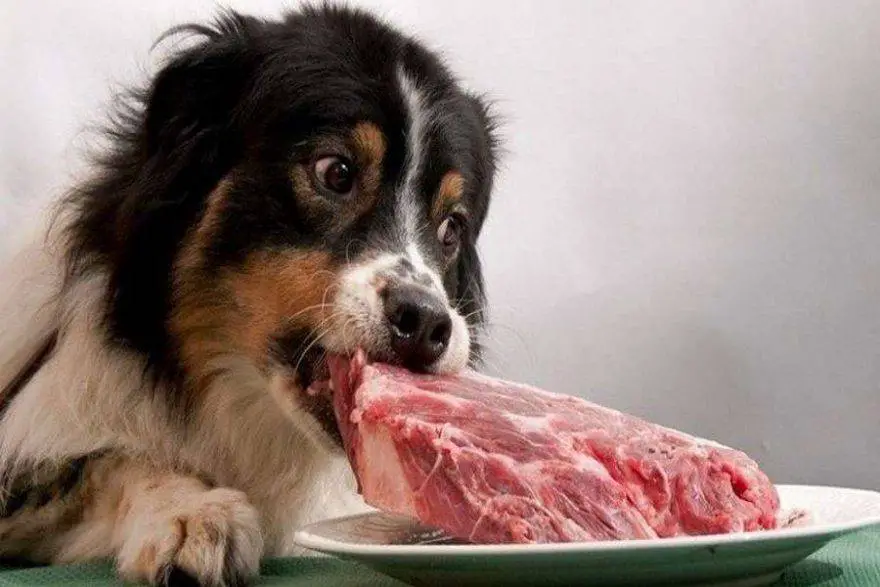Over the past few years, more and more pet owners are looking at ways of moving their dogs off of commercially produced dog food to more home made options. They are doing this to gain more control over exactly what is in their dog’s diet. This is a similar trend to what we are seeing with health conscious people. As they move their own diets towards healthier, fresher, organic foods, they are naturally looking to do the same for their pets.
In this article we will look at raw food diets for dogs, why people are doing it, what the pros and cons and how to feed your dog raw food.
What is a Raw Food Diet?
A raw food diet is just what it sounds like: a diet comprised of raw food similar to what a dog’s wild ancestors would have eaten. Raw diets are referred to as evolutionary diets, biologically appropriate raw food (BARF), primal diets or raw meat and bones (RMB).
Raw diets can include a great many kinds of meat, bones and vegetables, including chicken, pork, beef, turkey, fish, eggs, organ meat, bones, broccoli, carrots and other fresh or frozen vegetables. Supplements, such as the essential fatty acids found in fish oil and cod liver oil, are also recommended for an optimal raw diet.
Keep in mind that although a homemade diet is also very nutritional, most preparation includes cooking: steaming rice, boiling chicken and cooking vegetables. A raw diet is just that: raw. It’s important to make this distinction because of the preparation and nutritional balance of both diets.
The Problem with Commercial Dog Food
Traditionally, manufactured dog foods, including kibble and wet food, rely heavily on grains as a binder for substandard protein sources, such as bone meal, chicken by-products and animal fat. Grains can include corn, corn gluten meal, rice and flour. If you are concerned that you aren’t feeding a healthy diet, look at the ingredients on the food package. If the first few ingredients are on the list above, you’re feeding the wrong food.
A great many pet food companies are now producing high-quality foods with healthy, all-natural ingredients, such as venison, chicken, beef, fish, brown rice, vegetables and potatoes. However, many people believe that a raw diet is still the best way to ensure your dog enjoys optimum health.
Another problem with commercial dog food is the way it’s made. The intense heat used to process commercial pet food reduces the nutritional value of the food, stripping it of nutrients like vitamins, minerals and enzymes. The cooking process effectively destroys the bulk of what nutrients are in the ingredients, whatever their quality.
In general, grains are thought to be bad for dogs. In small amounts, especially brown rice, grains are healthy and safe to feed. However, the percentage of grains in manufactured dog food is far too high. Some veterinarians believe that dogs don’t have the appropriate enzymes for digesting grains, which can lead to organ problems, indigestion or lower bowel infection. Grain-based kibble is also more likely to create dental problems, such as bacterial infections, tooth decay and bad breath.
Benefits to Feeding a Raw Diet
The main purpose of feeding a raw diet is to maximize the health of your dog, increase his lifespan and prevent veterinary problems. A balanced raw diet can give your dog a healthier coat, cleaner teeth, fresher breath and stool that is smaller and less odorous. Because their stool is created from on lean meat and bones, it is much firmer, thus reducing the chances of full or infected anal glands. Raw food boosts your dog’s neurological and immune systems, improve digestion, and strengthens your dogs jaw, neck and shoulder muscles as he tears the meat and chews the bones.
But most important is your dog’s overall physical well-being. He’ll be more alert and active, and it will be easier to keep him at an ideal weight; without the high-calorie grains and fats in most commercial dog food, he’ll eat only protein, bones and vegetables, all healthy, low-calorie foods.
Raw diets are also great for dental health. Gnawing and chewing on bones scrapes off dental plaque, keeping teeth clean. The tendons, cartilage and ligaments in raw meat can even act as dental floss, cleaning food and bacteria from between your dog’s teeth.
When you’re feeding a raw diet, you’re also feeding his instincts. Before we domesticated them, dogs lived in the wild, hunting, killing and devouring prey. Although we have generally bred out these traits, except in hunting dogs, they still retain the instinct for their primal diet: raw meat and bones.
The Connection between Grains & Allergies
Many pet owners turn to a raw diet to help their pets with food allergies. Commercial dog food is high in ingredients that can cause allergic reactions in dogs, especially grains like wheat and corn. Because raw food doesn’t contain these grains, the potential for food allergies is greatly reduced. A raw diet rich in Omega-3 fatty acids promotes a healthy coat, improves skin and boosts your dog’s immune system. If you and your vet have ruled out other causes for persistent allergies, a raw diet might be exactly what your dog needs.
Problems with a Raw Diet
No diet is perfect, including a raw diet. When eating raw bones, even the correct kind of bones, there’s still a possibility that a bone fragment could cause intestinal obstructions or perforation, and there is also a risk of your dog breaking or damaging a tooth while chewing on a bone. However, these risks are relatively minor, and close monitoring while your dog is eating is an effective way to minimize problems.
Another concern is bacteria and parasites. One of the few benefits of the intense heat commercial dog manufacturers use in cooking kibble is that it destroys bacteria and parasites, a serious concern in recent years, when salmonella and E. coli poisoning have become more common. In a 2006 U.S. government study, 16.3% of the chickens tested were contaminated with salmonella. A later study showed that of the 25 commercially produced raw diets they examined, 20% contained salmonella and 64% contained E. coli bacteria. Raw meats can also contain harmful parasites, such as roundworm, tapeworm and other small organisms.
Although there is no conclusive evidence, many veterinarians and raw feeders believe that because a dog’s natural diet involves eating raw meat in the wild, where it would also contain bacteria and parasites, dogs have developed intestinal systems that are resistant to most bacterial and parasitic infections.
Convenience and expense are other concerns. It can take much longer to prepare a raw diet than it does to feed kibble or wet food, and meat and bones can be expensive, especially if you have a large-breed dog. If you choose prepackaged frozen food, you’ll enjoy the most convenience, but you’ll also pay a higher price.
The biggest risk involved with feeding a raw diet is failing to feed a balanced diet. Dogs need variety in their diets, and if you don’t provide it and meet all their nutritional needs, a raw diet can be worse for your dog than a commercially produced one.
How to Feed a Raw Diet
You can feed a wide variety of meats, including chicken, turkey, lamb, beef, pork, fish, rabbit, venison and other forms of wild game. Turkey necks are popular, as are beef ribs. You can use butcher’s scraps, packaged meats and frozen meats.
The trick for success with feeding a raw diet is giving your dog the right kind of bones. If feeding chicken, turkey or other fowl, you should never give your dog a hollow, load-bearing bone, such as leg and thigh bones, which can splinter and cause intestinal perforations. Chicken breasts and wings are safe because the bones are too dense to splinter. Meat and knuckle bones are the best kind of bones to feed; marrow bones are filled with fat and are best used as a treat.
Your dog will love just about any kind of vegetables, frozen, fresh or pureed. Carrots, broccoli, cauliflower, cabbage, peas, beans, pumpkin, summer squash and tomatoes are all great choices. Although he may turn up his nose at them at first, he’ll soon learn to love vegetables. A good trick for introducing them to your dog’s diet is to puree them and freeze them in a baggie with a little chicken broth. Serve a spoonful with each meal.
Many people also add supplements to their dog’s raw diet. Dr. Billinghurst, the veterinarian who literally wrote the book on the BARF diet, sells a variety of supplements that include flaxseed, yeast, potassium, barley and a variety of ground vegetables. You might also choose to include glucosamine and chondroitin, natural substances that boost joint health. It isn’t necessary to supplement the amount of calcium and iron in your dog’s diet; the bones and meat will more than suffice to feed those nutritional needs.
Although the ideal raw meal will contain the appropriate balance of meat, bones, vegetables and supplements, not every meal has to be so well-rounded. As long as you serve the amount of each ingredient your dog needs each week, there’s no need to prepare a full meal daily.
A convenient—if an expensive—way to feed a raw diet is to use a frozen prepackaged food. Dr. Billinghurst’s BARF patties are very popular, as is Steve’s Real Food, which are frozen cubes of meat, bone and vegetables. Check your local quality pet store or feed barn for the best prices.
The amount of raw food you give your dog will vary according to your dog’s body, weight and lifestyle. A good rule of thumb is to feed your dog 2% of his body weight per day, separated into two meals. Adjust that amount according to your dog’s metabolism and activity level. If you notice your dog is gaining or losing too much weight, adjust his diet accordingly.
As you experiment with feed your dog a raw diet, pay attention to his behavior, physical condition and general health. You should see improvement in all three, but if you don’t, consult your veterinarian.








